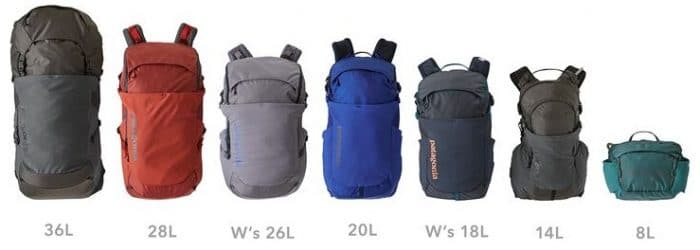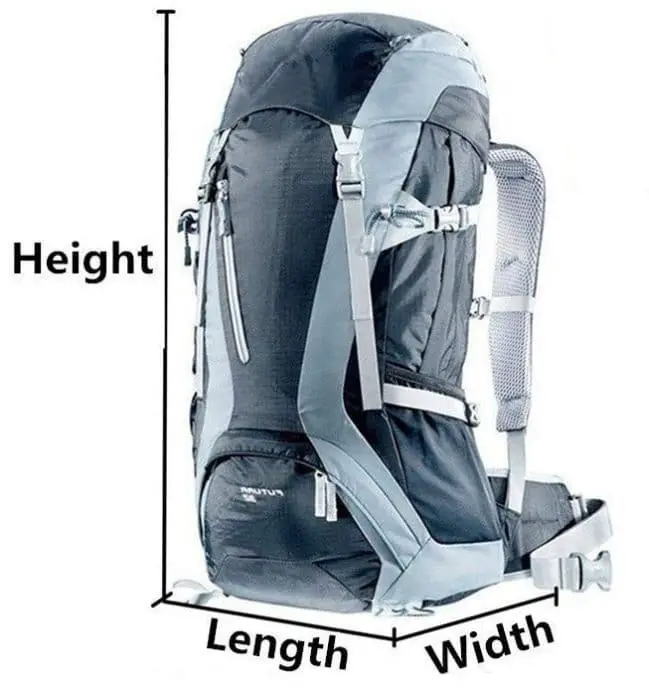When choosing a Bug Out Backpack, I’ve noticed much confusion about the capacity of backpacks.
Many packs claim the exact same capacity, but we find that one backpack holds much more gear than the other.
It is somewhat confusing, more so, because the process for measuring backpack capacity has been standardized for many years.

Backpack Sizes Cubic Inches vs Liters
The standard for determining the capacity of a backpack entails using 20mm plastic balls as the filler. Packs are loaded up, then emptied. The 20mm balls are then dumped into a measuring device.
According to the standard, capacity measurements should not include any compartments that are not entirely sealed by zippers, such as shovel pockets, bottle holders, compression pockets, etc.

We suspect that some of the overstated backpack capacities, that we see, must include the additional capacity of these pockets. This makes online backpack selection very frustrating, since we lack the ability to compare the sizes in person.
Why is that some backpacks are measured in cubic inches and some are measured in liters. Many companies state their capacities in liters, but its in no way a universal thing.
Cubic inches vs liters Conversion Calculator:
Click here for calculator if on mobile device
Backpack Size vs Liters vs Cubic Inches Chart Metric – US Conversion Chart.
Keep in mind different manufacturer’s will label a pack different sizes for different cubic inch or liter capacity.
I would not recommend paying too much attention to the size label, as all it is is a label. The two most important factors of choosing a bag are comfort, size, and desired capacity. You determine what those are, based solely on your needs.
The sizes represented in the below chart are a rough estimation of what you can generally find from most pack manufacturers that correspond to a range of cubic inches and liters.
| Liters | Cubic Inches | Size (Estimate) |
| 10 | 610 | Kids or XS |
| 20 | 1200 | XS or Woman’s |
| 30 | 1800 | Small or Women’s |
| 40 | 2441 | Small, Med, or Women’s |
| 50 | 3051 | Small or Medium |
| 55 | 3356 | Medium |
| 60 | 3661 | Medium |
| 65 | 3967 | Medium or Large |
| 70 | 4272 | Large |
| 75 | 4577 | Large |
| 80 | 4882 | Large or XL |
| 85 | 5187 | XL |
| 90 | 5492 | XL |
Calculating Backpack Dimensions to Cubic Inches (or Liters)
If you want to find the cubic inches or liters of your pack based on the dimensions, the easiest way to obtain it is by using basic math.
Simply multiply the length x width. Then take that result and multiply it by the depth, and that number is the cubic inches of your pack based on it’s dimensions
Of course, if you want convert the cubic inches to cubic liters, simply use the chart or calculator above.
General Sizing (in no way an exact science)
- Daypacks will be under 2,500 cubic inches or 40 liters
- Weekend packs are typically 2,500 to 4,000 cubic inches or 40 to 65 liters
- Weeklong packs range from 4,000 to 6,000 cubic inches or 65 to 95 liters
- Expedition packs are 6,000 cubic inches or 95 liters and up
Basic (rough) pack volume rules of thumb:
- 1 day trip or hike: look for something in the 40 liters range (or 2500 cubic inches)
- 1 or 2 night trip or outing (and packing light): a pack in the 50 liter range (or 3,000 cubic inches)
- Those who need more space (everything but the kitchen sink), look for a larger pack with a volume of 65 to 70 liters (or more than 4,000 cubic inches).
Some sample data to chew on:
- ALPS OutdoorZ Commander Freighter Frame Plus Pack Bag – 5250 Cubic Inches
- High Sierra 75 Liter Internal Frame Pack (Classic Series 59501 Appalachian) – 4580 cubic inches or 75 liters
- ILBE (Improved Load Bearing Equipment) – 4500 cubic inch main rucksack, can be mated with an additional 1500 cubic inch Assault Pack, along with 100 ounces of liquid in a hydration bladder. This would give you 6000 cubic inches of rucksack space, on your back. (Military Surplus)
- Kelty Trekker External Frame Pack – 3950 Cubic Inch volume
- Large ALICE pack – Main compartment 2,800 cubic inches. Total Capacity 3,800 cu.in. (Military Surplus)
- Osprey Packs Atmos 65 Backpack – 3,783 cubic inches (weighs 3 lbs 6 oz)
- Teton Sports Scout 3400 Internal Frame Backpack – 3400 Cu. In

- Medium ALICE pack – 2,350 cu. in. (Military Surplus)
This guide to Backpacking sizes cubic inches vs liters should help reduce the confusion between the sizes of backpacks, allowing you to choose the proper size.
Why You Need to Find the Right Backpack Size
Whether you’re going out into the boardroom or into wilderness, backpacks are extremely useful. You can use them to carry almost anything you need professionally or personally.
However, for them to actually work for you, finding the right size is critical. This allows you to fit in your things and carry them without experiencing backpain or discomfort in your hips or neck. This will allow you to pack out with the maximum amount of gear while allowing you to hike more comfortably for longer distances.
Things to Consider When Looking for The Best Backpack Size for You
For you to actually pick the right size, there are a couple of things you need to consider.
One is your packing style. If you are the type of person who prefers to roll his clothes and other items to make them fit inside your backpack, a smaller bag will work for you. For packing things that can’t be rolled, you’ll need a bigger bag.

Another thing you need to consider is the weather. If you’re planning on camping or hiking, you’ll need a bag with more space than usual to carry your hydration packs.
You’ll also need a big bag if you’ll be traveling in winter. You should have enough space to fit in you jackets, sweaters, and snowshoes.

You should consider the bag’s weight capacity, too. In general, the bigger the size of the bag, the heaver it will be. With this in mind, think about how much you can actually carry.
The size of the bag won’t matter if you won’t be able to carry it.
The most important thing you need to consider is your body type. Make sure that your bag isn’t too big or too small for you to ensure your comfort and safety.
Now, here’s how you can do that:
- Locate the bony bump behind your neck. You can lean forward to find the spot easier. This is your C7 cervical vertebra and the upper area of your torso length.
- Slide your hands down until you get to the top area of your hipbones. This is your iliac crest. After locating this spot, point your index finger forward and your point your thumbs inward. The imaginary line you’ll be able to create between thumbs is the bottom area of the torso length.
- Ask someone to measure the distance between your C7 cervical vertebra and your thumbs. Mark this as your torso length.

In addition to your torso length, measuring your waist size is important, too. Most of your backpack’s weight will be supported by your hips.
A standard hipbelt should be enough if your hip size ranges from mid 20 to 40 inches. If you have a narrow waist, you may need to find a smaller size.
Some of this data was taken from Choosing a Bug Out Backpack.







thanks a lot for making this conversion easier to understand.
I am clearly confused. I have a Kelty Redwing 2650 LE. I looked it up and it claims to be a 40L backpack.
The measurements are 22.5″ x 16.5″ x13.5″. When multiplied out it comes to 5,012 cubic inches which according to your table it would be an 83 L backpack. Where did I go wrong.
your site was the only one i found which clearly states the correct way to measure backpacks from the size in inches to determine its size in liters. like you say it is not exact but in the case of getting a good idea of your backpack size in liters it works fine.
Your calculations are for a perfect square with no material and no curves. With the pack’s shape and material it is reduced in actual carry capacity to 2650 cubic inches. Hope that helps.